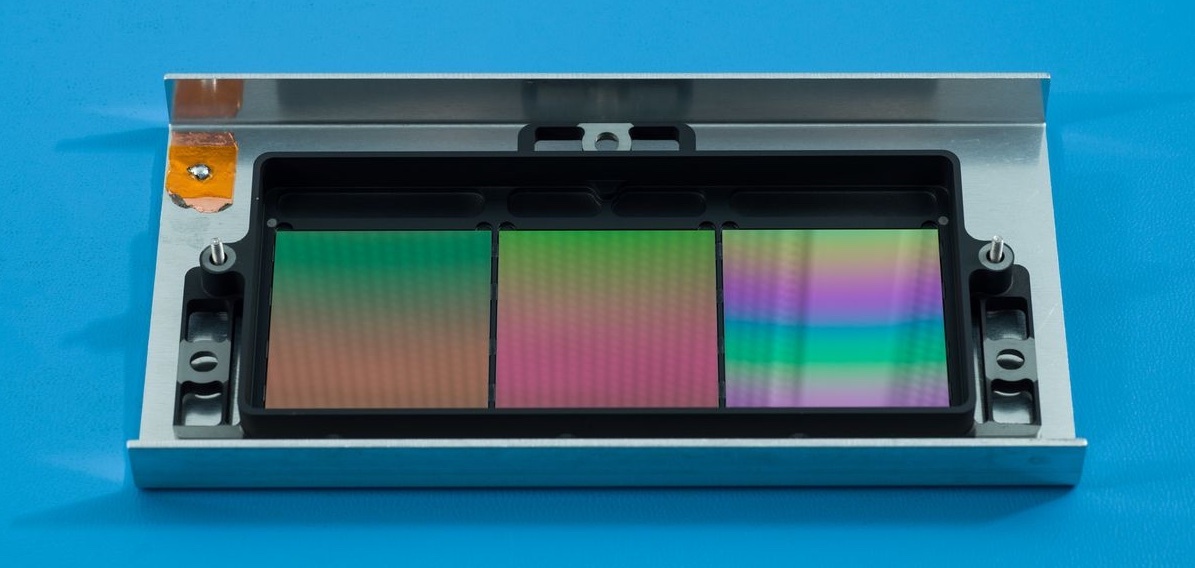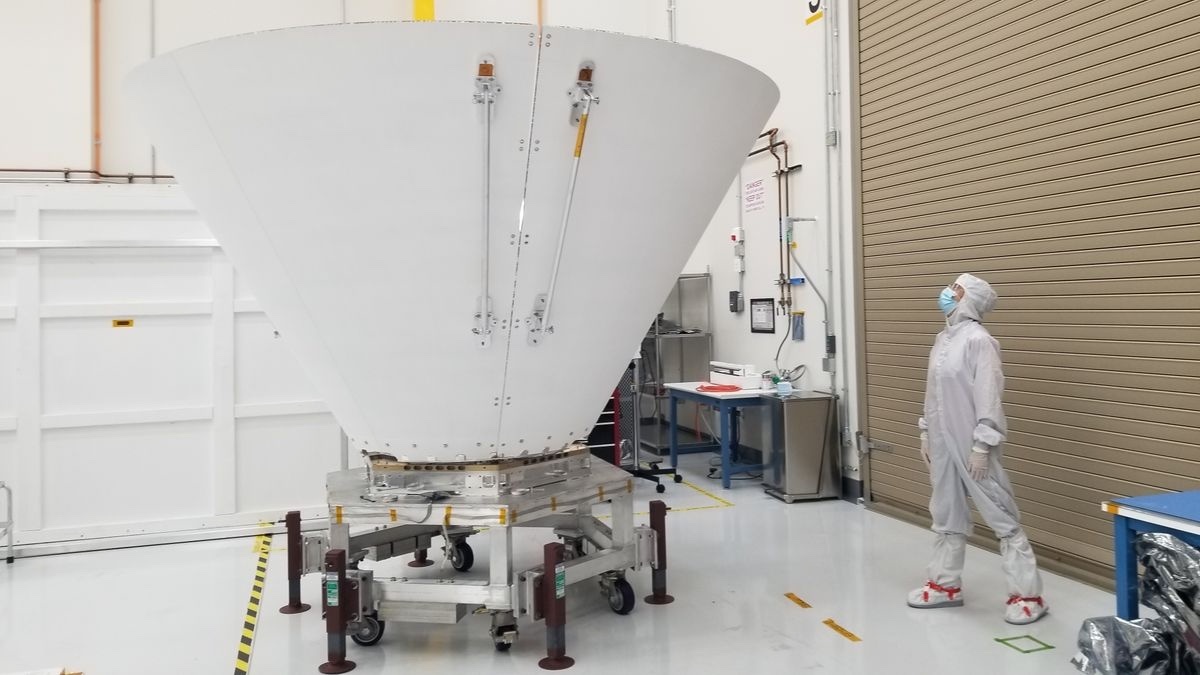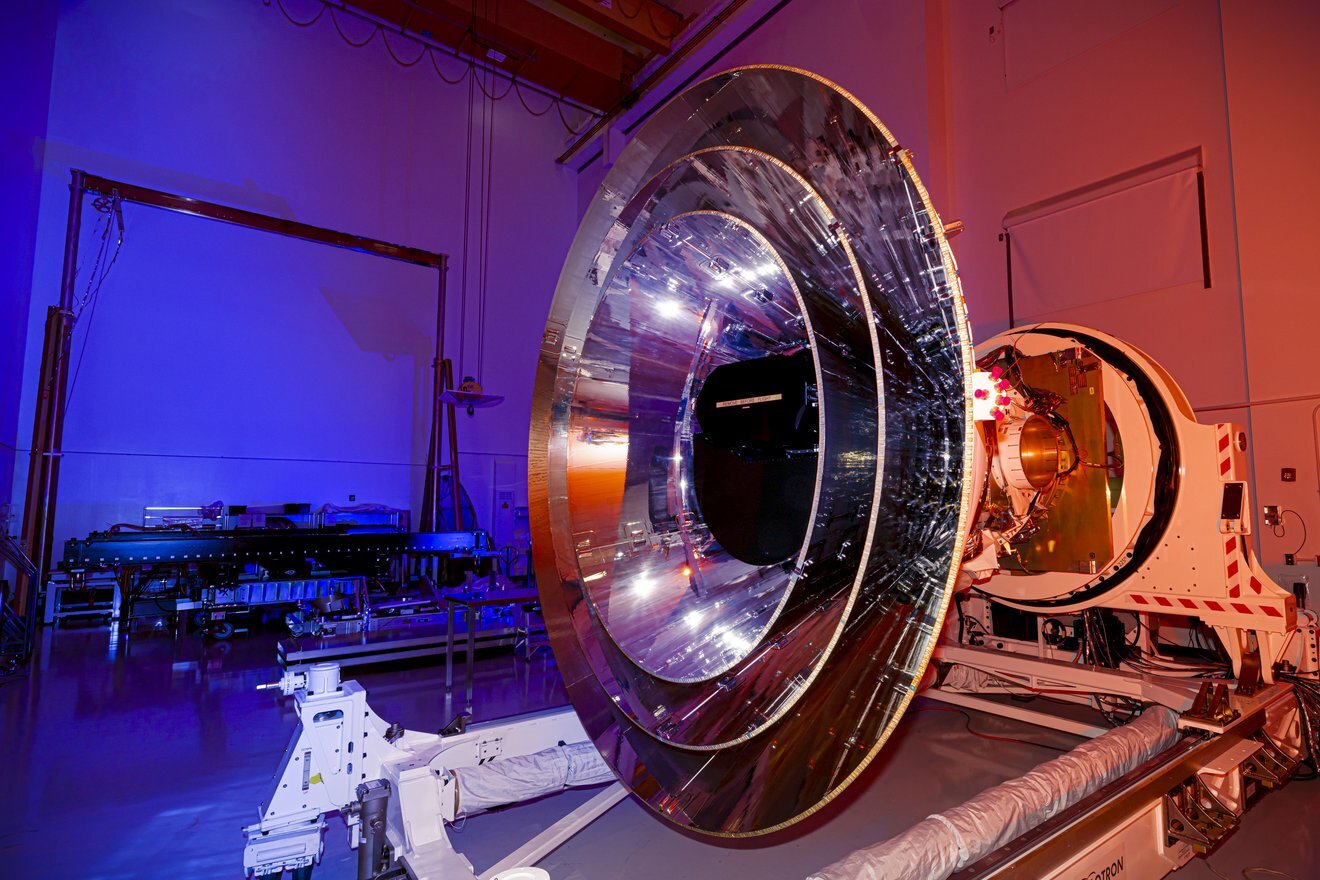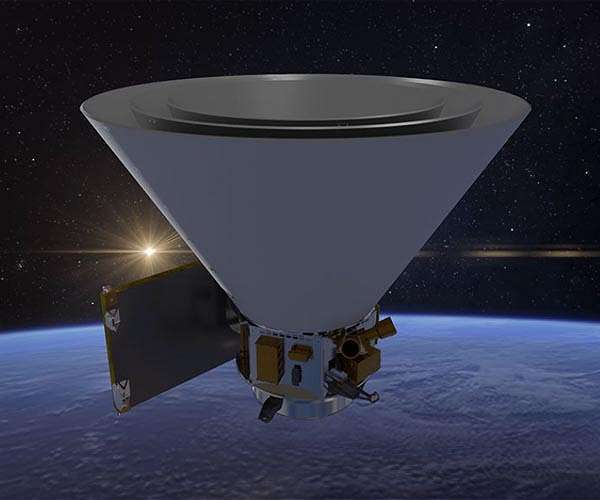14.02.2019
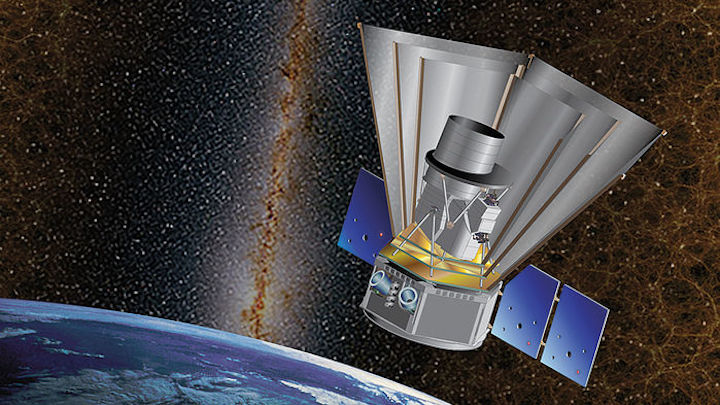
SPHEREx would map hundreds of millions of galaxies in the infrared.
NASA JPL
NASA has just given the green light to a mission that will study multiple eras of cosmic history, from the earliest fractions of a second after the big bang to modern-day planetary formation. The space-based Spectro-Photometer for the History of the Universe, Epoch of Reionization, and Ices Explorer (SPHEREx) will map the entire sky in the infrared—wavelengths that are mostly blocked by Earth’s atmosphere.
“It’s a great moment,” says SPHEREx Principal Investigator James Bock, an astronomer at the California Institute of Technology in Pasadena, who says he’s glad to be just one member of a large team. “If it was just me, I’d be really panicked.”
SPHEREx beat out one other finalist for NASA’s middle-class explorer program (MIDEX), a competitive mission line whose costs are capped at $250 million. Previous MIDEX missions include the Transiting Exoplanet Survey Satellite (TESS), which launched last year. SPHEREx has been awarded $242 million and is expected to launch in 2023.
One of SPHEREx’s main goals will be to determine the distance from Earth to 300 million galaxies and map out their 3D structure. By looking at over-densities and under-densities in their large-scale distribution, the mission might be able to tease out tiny effects from a hypothesized period in the early universe known as inflation, when the universe expanded exponentially in size in the moments after the big bang.
Primordial quantum mechanical fluctuations from the newborn universe, boosted by inflation, left ripples on the cosmic microwave background, the most distant light that telescopes can see. Similarly, inflation could have generated a signature on galactic distribution that would give researchers clues about its details. Some theories posit that the energy for inflation came from a field with an associated particle known as an inflaton.
“It’s possible that view is simplistic,” Bock says. “There are reasons to think there will be multiple fields involved.”
SPHEREx will also gather information about the total light emitted by galaxies, giving insights into an under-studied era known as reionization, when the first stars began lighting up the universe and heating up clouds of hydrogen. Finally, closer to home, the mission will map out the abundance of ices in molecular clouds within the Milky Way. As these clouds collapse, they form stars and planets, though the details of the process are still not well known.
“Ice on the dust grains may be important for accretion,” Bock says. “For instance, causing things to stick together better.”
In the MIDEX competition, SPHEREx won out over the Arcus satellite, which would have studied galaxies in x-rays to get a better understanding of the supermassive black holes at their centers. An exoplanet mission, the Fast INfrared Exoplanet Spectroscopy Survey Explorer (FINESSE), was originally another finalist. But NASA asked its designers to instead contribute technology and expertise to a similar observatory in development by the European Space Agency called the Atmospheric Remote-sensing Exoplanet Large-survey (ARIEL).
Quelle: Science
----
Update: 3.03.2019
.
Q&A: UA researcher chosen for NASA's SPHEREx mission

Tim Eifler is an assistant professor of astronomy at the University of Arizona. He will be participating in NASA's upcoming SHPEREx misison.
Assistant professor of astronomy Tim Eifler is one of the two University of Arizona astronomy and physics professors who will be working on the National Aeronautics and Space Administration's Spectro-Photometer for the History of the Universe, Epoch of Reionization and Ices Explorer, or SPHEREx, mission.
Eifler will be working with UA assistant professor of astronomy and physics Elisabeth Krause. A team at the California Institute of Technology and NASA's Jet Propulsion Laboratory will lead the SPHEREx mission.
Daily Wildcat: What will be your role in the SHPEREx mission?
Tim Eifler: I’m in charge of combining SPHEREx with external data sets. SPHEREx is an all-sky survey in the infrared, so it will overlap with a lot of other ongoing surveys, which will cover different wavelengths.
DW: What is the process of being selected to work for NASA?
TE: The selection process is that you first submit a proposal to NASA and then you have an in-depth Phase A study. Originally it was ordered 15, 20 missions at that phase one study, and three of these missions were chosen.
One of these missions was then turned into a science team that joined a European mission that was exactly of the same science story. So now, at the end of the day, it’s just us and ARCUS, which is a data x-ray mission lead out of Massachusetts Institute of Technology and Harvard [University], together with [NASA's] Goddard [Institute for Space Studies at Columbia University].
DW: What are the goals of this mission?
TE: There’s three main goals: the origin of the universe, the origin and history of galaxies and the origin of water in planetary systems. With the first one, one of the big questions today is dark energy, but what SPHEREx is going to investigate is the very early phase that’s called inflation.
SPHEREx is studying inflation that is at the origin of the universe. Inflation is a time where the universe expands very rapidly, much more rapidly than it is expanding today. Some of the first light we actually see is the cosmic microwave background, and inflation actually happened before that.
I work on understanding the physics of inflation, of this rapid expansion of the very early universe. Given that SPHEREx will provide this fantastic all-sky dataset, it will be useful for all sorts of cosmology applications. It will also be useful for understanding dark energy
The mission is very broad, in the sense that it will explain the physics of the universe in very early times and also very locally in our galaxy. It’s going to constrain how much water, where it is – map of all the ice in the galaxy.
DW: What information are you expecting to collect from the mission?
TE: SPHEREx is an all-sky survey with 96 different bands, which means you see one object in 96 different colors. What filter you put in front of the telescope affects what light comes through it, so SPHEREx has 96 different bands where light comes through. So you see the 300 million galaxies in 96 different colors.
That allows you to look for very specific features in these galaxies to understand exactly where they are in redshift and where they are in line-of-sight distance.
DW: How long are you expecting this mission to take?
TE: Two to three years of observations. But if you look at the history of NASA missions, you’ll see that if they work well, their grant lasts longer.
DW: Why do you think it’s important to us to keep exploring space?
TE: I think it is important. I know humanity focuses a lot on problems on earth, and rightly so. I rarely see humans being inspired by anything else than space exploration.
Secondly, it is enormously beneficial to the economic growth of the world. Fundamental science is something that fuels all the innovation we have. In some cases, fundamental scientific research does not immediately translate into economic gain, but it does in the long term; it’s what propels our society as a whole and what causes these big paradigm shifts.
Space exploration is extremely important to inspire humanity and to also make sure that we make these big jumps in our evolution forward.
Quelle: THE DAILY WILDCAT
----
Update: 6.01.2021
.
A New NASA Space Telescope, SPHEREx, Is Moving Ahead

NASA's upcoming space telescope, the Spectro-Photometer for the History of the Universe, Epoch of Reionization and Ices Explorer, or SPHEREx, is one step closer to launch. The mission has officially entered Phase C, in NASA lingo. That means the agency has approved preliminary design plans for the observatory, and work can begin on creating a final, detailed design, as well as on building the hardware and software.
Managed by NASA's Jet Propulsion Laboratory in Southern California, SPHEREx is scheduled to launch no earlier than June 2024 and no later than April 2025. Its instruments will detect near-infrared light, or wavelengths several times longer than the light visible to the human eye. During its two-year mission, it will map the entire sky four times, creating a massive database of stars, galaxies, nebulas (clouds of gas and dust in space), and many other celestial objects.
About the size of a subcompact car, the space telescope will use a technique called spectroscopy to break near-infrared light into its individual wavelengths, or colors, just like a prism breaks sunlight into its component colors. Spectroscopy data can reveal what an object is made of, because individual chemical elements absorb and radiate specific wavelengths of light. It can also be used to estimate an object's distance from Earth, which means the SPHEREx map will be three-dimensional. SPHEREx will be the first NASA mission to build a full-sky spectroscopy map in near-infrared, and it will observe a total of 102 near-infrared colors.
"That's like going from black-and-white images to color; it's like going from Kansas to Oz," said Allen Farrington, the SPHEREx project manager at JPL.
Before entering Phase C, the SPHEREx team successfully completed a preliminary design review in October 2020. During this multiday process, the team had to demonstrate to NASA leadership that they can make their complex, cutting-edge mission design a reality. Usually, the review is done in-person, but with COVID-19 safety precautions in place, the team had to adjust their presentation to a new format.
"It felt like we were producing a movie," said Beth Fabinsky, SPHEREx's deputy project manager at JPL. "There was just a lot of thought put into the production value, like making sure the animations we wanted to show would work over limited bandwidth."
Three Key Questions
The SPHEREx science team has three overarching goals. The first is to look for evidence of something that might have happened less than a billionth of a billionth of a second after the big bang. In that split second, space itself may have rapidly expanded in a process scientists call inflation. Such sudden ballooning would have influenced the distribution of matter in the cosmos, and evidence of that influence would still be around today. With SPHEREx, scientists will map the position of billions of galaxies across the universe relative to one another, looking for statistical patterns caused by inflation. The patterns could help scientists understand the physics that drove the expansion.
The second goal is to study the history of galaxy formation, starting with the first stars to ignite after the big bang and extending to present-day galaxies. SPHEREx will do this by studying the faint glow created by all the galaxies in the universe. The glow, which is the reason the night sky is not perfectly dark, varies through space because galaxies cluster together. By making maps in many colors, SPHEREx scientists can work out how the light was produced over time and start to uncover how the first galaxies initially formed stars.
Finally, scientists will use the SPHEREx map to look for water ice and frozen organic molecules - the building blocks of life on Earth - around newly forming stars in our galaxy. Water ice gloms onto dust grains in cold, dense gas clouds throughout the galaxy. Young stars form inside these clouds, and planets form from disks of leftover material around those stars. Ices in these disks could seed planets with water and other organic molecules. In fact, the water in Earth's oceans most likely began as interstellar ice. Scientists want to know how frequently life-sustaining materials like water are incorporated into young planetary systems. This will help them understand how common planetary systems like ours are throughout the cosmos.
Multiple mission partners are beginning construction on various hardware and software components for SPHEREx. The telescope that will collect near-infrared light will be built by Ball Aerospace in Boulder, Colorado. The infrared cameras that capture the light will be built by JPL and Caltech (which manages JPL for NASA). JPL will also build the sun shields that will keep the telescope and cameras cool, while Ball will build the spacecraft bus, which houses such subsystems as the power supply and communications equipment. The software that will manage the mission data and make it accessible to scientists around the world is being built at IPAC, a science and data center for astrophysics and planetary science at Caltech. Critical ground support hardware for testing the instruments will be built by the Korea Astronomy and Space Science Institute (KASI), a science partner on the mission in Daejeon, South Korea.
The SPHEREx team is scheduled to spend 29 months building the mission components before entering the next mission phase, when those components will be brought together, tested, and launched.
SPHEREx is managed by JPL for NASA's Astrophysics Division within the Science Mission Directorate in Washington. The mission's principal investigator, James Bock, has a joint position between Caltech and JPL. The science analysis of the SPHEREx data will be conducted by a team of scientists located in 10 institutions across the U.S., and in South-Korea.
Quelle: NASA
----
Update: 6.02.2021
.
NASA Awards Launch Services Contract for SPHEREx Astrophysics Mission
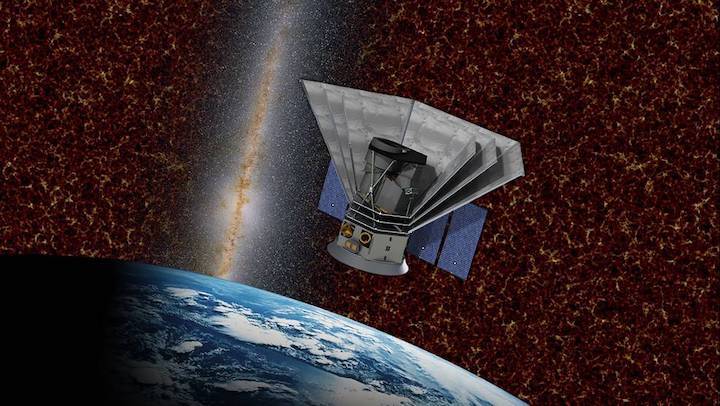
NASA has selected Space Exploration Technologies (SpaceX) of Hawthorne, California, to provide launch services for the Spectro-Photometer for the History of the Universe, Epoch of Reionization, and Ices Explorer (SPHEREx) mission. SPHEREx is a planned two-year astrophysics mission to survey the sky in the near-infrared light, which, though not visible to the human eye, serves as a powerful tool for answering cosmic questions involving the birth of the universe, and the subsequent development of galaxies.
It also will search for water and organic molecules – essentials for life as we know it – in regions where stars are born from gas and dust, known as stellar nurseries, as well as disks around stars where new planets could be forming. Astronomers will use the mission to gather data on more than 300 million galaxies, as well as more than 100 million stars in our own Milky Way galaxy.
The total cost for NASA to launch SPHEREx is approximately $98.8 million, which includes the launch service and other mission related costs.
The SPHEREx mission currently is targeted to launch as early as June 2024 on a Falcon 9 rocket from Space Launch Complex-4E at Vandenberg Air Force Base in California.
NASA’s Launch Services Program at the agency’s Kennedy Space Center in Florida will manage the SpaceX launch service. The mission, which is funded by the Astrophysics Division of NASA’s Science Mission Directorate at the agency’s headquarters in Washington, is led by the Explorer’s Program at NASA’s Goddard Space Flight Center in Greenbelt, Maryland. NASA’s Jet Propulsion Laboratory in Southern California is responsible for the mission’s overall project management, systems engineering, integration, and testing and mission operations.
Quelle: NASA
----
Update: 28.03.2022
.
NASA finalizes plans for its next cosmic mapmaker

SPHEREx and Webb differ not only in their approach to studying the sky but in their physical parameters. Webb is the largest telescope to ever fly in space, with a 21.3-foot (6.5-meter) primary mirror to capture the highest-resolution images of any space telescope in history. The observatory protects its sensitive instruments from the Sun's blinding light with a sunshield that's as big as a tennis court. SPHEREx, on the other hand, has an 8-inch primary mirror and a sunshield that is just 10.5 feet (3.2 meters) across.
NASA's upcoming SPHEREx mission will be able to scan the entire sky every six months and create a map of the cosmos unlike any before. Scheduled to launch no later than April 2025, it will probe what happened within the first second after the big bang, how galaxies form and evolve, and the prevalence of molecules critical to the formation of life, like water, locked away as ice in our galaxy. Achieving these goals will require cutting-edge technology, and NASA has this month approved final plans for all the observatory's components.
"We're at the transition from doing things with computer models to doing things with real hardware," said Allen Farrington, SPHEREx project manager at NASA's Jet Propulsion Laboratory in Southern California, which manages the mission. "The design for the spacecraft, as it stands, is confirmed. We have shown that it's doable down to the smallest details. So now we can really start building and putting things together."
To answer big questions about the universe, scientists need to look at the sky in different ways. Many telescopes, like NASA's Hubble Space Telescope, are built to focus on individual stars, galaxies, or other cosmic objects, and to study them in detail. But SPHEREx (which stands for Spectro-Photometer for the History of the Universe, Epoch of Reionization and Ices Explorer) belongs to another class of space telescopes that quickly observe large portions of the sky, surveying many objects in a short period of time.
SPHEREx will scan over 99% of the sky every six months; by contrast, Hubble has observed about 0.1% of the sky in more than 30 years of operations. Although survey telescopes like SPHEREx can't see objects with the same level of detail as targeted observatories, they can answer questions about the typical properties of those objects throughout the universe.
For example, NASA's recently launched James Webb Space Telescope will target individual exoplanets (planets outside our solar system), measuring their size, temperature, weather patterns, and makeup. But do exoplanets, on average, form in environments that are conducive to life as we know it?
With SPHEREx, scientists will measure the prevalence of life-sustaining materials like water that reside in icy dust grains in the galactic clouds from which new stars and their planetary systems are born. Astronomers believe the water in Earth's oceans, thought to be essential to life starting on Earth, originally came from such interstellar material.
"It's the difference between getting to know a few individual people, and doing a census and learning about the population as a whole," said Beth Fabinsky, deputy project manager for SPHEREx at JPL. "Both types of studies are important, and they complement each other. But there are some questions that can only be answered through that census."
SPHEREx and Webb differ not only in their approach to studying the sky but in their physical parameters. Webb is the largest telescope to ever fly in space, with a 21.3-foot (6.5-meter) primary mirror to capture the highest-resolution images of any space telescope in history. The observatory protects its sensitive instruments from the Sun's blinding light with a sunshield that's as big as a tennis court. SPHEREx, on the other hand, has an 8-inch primary mirror and a sunshield that is just 10.5 feet (3.2 meters) across.
But both observatories will collect infrared light - wavelengths outside the range that human eyes can detect. Infrared is sometimes called heat radiation because it is emitted by warm objects, which is why it's used in night vision equipment.
The two telescopes will also both use a technique called spectroscopy to break infrared light into its individual wavelengths, or colors, just like a prism breaks sunlight into its component colors. Spectroscopy is what enables both SPHEREx and Webb to reveal what an object is made of, because individual chemical elements absorb and radiate specific wavelengths of light.
In order to pursue big-picture questions, the SPHEREx team first had to answer more practical ones, such as whether the instrument on board could survive the environment in space, and if all its components could be packed together and operate as a system. Last month, the team's final plans were approved by NASA, a step that the agency calls critical design review or CDR. This marks a major milestone for the mission on the way to launch.
"COVID continues to be a big challenge for us in developing new space projects. Everything the country went through over the past year, from supply chain disruptions to working at home with kids, we've gone through as well," said SPHEREx Principal Investigator James Bock, who is a scientist at JPL and Caltech in Pasadena, California. "It's really incredible to be part of a team that has handled these difficulties with enthusiasm and a seemingly unlimited supply of determination."
Quelle: SD
----
Update: 18.08.2022
.
Test Chamber for NASA’s New Cosmic Mapmaker Makes Dramatic Entrance
The SPHEREx mission will create a 3D map of the entire sky. Its cutting-edge instruments require a custom-built chamber to make sure they’ll be ready to operate in space.
Custom built by the Korean Astronomy and Space Science Institute (KASI), a large stainless steel test chamber for NASA’s SPHEREx telescope required a very special delivery to Caltech in Pasadena, California, where it will be used to ensure the spacecraft can withstand the rigors of space.
After three years of design and construction, a monthlong boat ride across the Pacific Ocean, and a lift from a 30-ton crane, the customized test chamber for NASA’s upcoming SPHEREx mission has finally reached its destination at Caltech’s Cahill Center for Astronomy and Astrophysics in Pasadena.
Set to launch no earlier than June 2024, SPHEREx (short for Spectro-Photometer for the History of the Universe, Epoch of Reionization and Ices Explorer) will make a unique map of the cosmos that will contain hundreds of millions of objects, including stars, galaxies, star-forming regions, and other cosmic wonders. Unlike any previous map, it will provide images of individual objects, as well as a spectrum for every point in the sky. Spectra can contain a treasure trove of information about cosmic objects, including their chemical composition, age, and the distance to faraway galaxies.
With this dynamic chart, scientists will be able to answer questions about what happened shortly after the big bang, the prevalence of life-sustaining molecules like water ice in our galaxy’s planet-forming regions, and how galaxies began and evolved over the universe’s lifetime.
But for SPHEREx to make that possible, the telescope must be able not only to withstand the rigors of space but also to thrive there. That’s where the custom test chamber comes in. About the size of a small SUV and made of stainless steel, the cylindrical chamber was built by the Korean Astronomy and Space Science Institute (KASI), a partner in the SPHEREx mission. It will be used to test SPHEREx’s detectors (essentially its cameras) and optics (the system that collects light from the cosmos).
Cold Light
Managed by NASA’s Jet Propulsion Laboratory, SPHEREx will detect infrared light, which human eyes can’t detect. Sometimes called heat radiation, it is emitted by warm objects, including stars and galaxies, as well as the telescope’s instruments. So the chamber is designed to cool the detectors to about minus 350 degrees Fahrenheit (about minus 200 degrees Celsius) to make sure their own heat won’t overwhelm the light from the objects they’re built to observe.
But first, the SPHEREx team needs to test whether the detectors are in focus. This is determined by their distance from the optics, similar to how moving a magnifying glass closer to or farther away from your eye brings objects into or out of focus. The team will have to get the distance between the detectors and the optics correct to within 0.0003 inches (7.5 micrometers), or about one-tenth the width of a human hair. To do this, they’ll point the optics and detectors at a projected source of infrared light located outside the chamber’s window, which is made of sapphire because glass blocks infrared. The source will serve as a stand-in for the objects that SPHEREx will observe in space, and the resulting image will tell engineers if the spacing is correct.

This illustration shows a cross section of NASA’s upcoming SPHERE mission, revealing the spacecraft’s telescope and detectors surrounded by three shiny photon shields that protect them from the Sun.
“A number of factors can influence the focus position of our instrument as it gets down to its operating temperature,” said Phil Korngut, the SPHEREx instrument scientist and a researcher at Caltech. “It’s absolutely essential that we get this thing sharply into focus before we fly, and the only way to accomplish that is through specific cryogenic optical testing in the environment provided by the KASI chamber.”
The chamber is also customized to calibrate the SPHEREx spectrometer, which will provide a spectrum of every point on the sky.
Long Journey
In 2018, KASI launched a mission called the Near-infrared Imaging Spectrometer for Star formation history (NISS), which has similarities to SPHEREx. Working on NISS gave the KASI team the right experience to build the custom chamber.
After traveling by ship from Korea to Long Beach, California, the chamber was transported north to Caltech. Too large to fit through the main entrance of its new home, it had to travel under the building: A 30-ton crane lifted off a removable section of an adjacent road and then lowered the test chamber, along with its components, into a high-ceilinged, windowless receiving room unofficially known as “the crypt.” The chamber was then wheeled into the SPHEREx test lab, where it will stay for about 18 months until the hardware tests are complete.
“Not only the SPHEREx team at KASI, but the whole Korean astronomical community are very interested in the SPHEREx data and its science objectives,” said Woong-Soeb Jeong, the principal investigator for SPHEREx for KASI. “So KASI’s participation in the SPHEREx mission is expected to have a great impact on the research in our astronomical community. That heritage will be of great help in developing our own medium- or large-class space telescope in the future.”
More About the Mission
SPHEREx is managed by JPL for NASA’s Astrophysics Division within the Science Mission Directorate in Washington. The mission’s principal investigator, James Bock, has a joint position between Caltech and JPL. Ball Aerospace in Boulder, Colorado, will supply the spacecraft. The science analysis of the SPHEREx data will be conducted by a team of scientists located at 10 institutions across the U.S. and in South Korea. Data will be processed and archived at IPAC at Caltech. The SPHEREx dataset will be publicly available.
Quelle: NASA
----
Update: 16.11.2023
.




